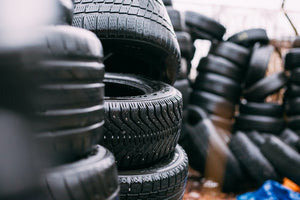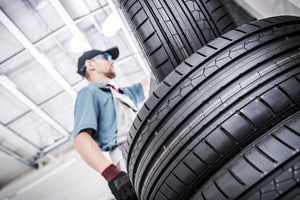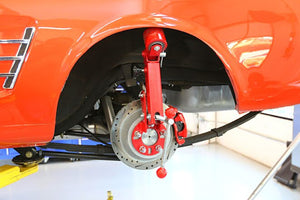
Are Spacers Safe or Not?
Nailing the perfect stance has always been on top of the list for most car guys - be it on a modest econo sedan or a souped-up garage queen.
Spacers come in when you still need minute fitment adjustments. But one thing’s always asked - Are spacers safe or not?
This article takes a look into some of the what’s and why’s of spacers. And in effect, we hope to answer the question concerning their safety and help debunk myths.
Let’s start!
What is a Wheel Spacer?

The wheel spacer is a round metal plate with holes that can fit wheel studs through. It also has a hole right in the middle. Because of these holes, the wheel spacer could even look like two knuckle dusters pieced together.

Its thickness could be anywhere from a fraction of an inch to something thicker, depending on the application.
Think burger patties. As the patty increases in thickness, the more space it creates between the buns. The wheel spacer is the burger patty and the buns are the wheel and hub.
__
Why Do You Use a Wheel Spacer?
As its name implies, a wheel spacer creates more space. It is placed in between the wheel and hub as a way to compensate for wheel offset.

The extra space it creates pushes the wheel further out of the axle. At times, the wheel spacer makes subtle changes that go unnoticed at first glance. Other times, it pops the wheel out of the fender by an inch or two.

By itself, a wheel spacer doesn’t seem like it adds too much to your car. But a pair can significantly increase your car’s track width, creating a wider stance.
From a performance point of view, having a wider stance can slightly improve your car’s handling. But for most car owners, wheel spacers work best for aesthetics.
__
What are The Common Materials Used on Wheel Spacers?
There are two common materials manufacturers use on wheel spacers. These are things that usually make up wheels as well.

The steel wheel spacer is the less expensive material between the two. Its density makes it harder and stronger. If you’re on a tight budget, buying steel wheel spacers is the easiest way to push your wheels further out.
However, being rigid isn’t always a good thing when it comes to wheel spacers. Steel is more prone to break or crack after consistent heavy beating. It is also heavier and more prone to rust and corrosion.
The aluminum wheel spacer comes at a higher price but for a good reason. It is more malleable and can be forged into custom patterns without breaking. It is also lighter than steel, relieving the wheel hub and other parts of excessive weight.
Aluminum is also resistant to corrosion, making it last a lot longer under normal conditions. While it seems to be expensive upfront, getting an aluminum wheel spacer is safer and more cost-friendly in the long run.
__
What’s the Difference Between Hub-Centric and Lug-Centric Wheel Spacers?
Just like wheels, wheel spacers can be hub-centric and lug-centric. The two differ in the way they fit the hub on installation.
The picture below illustrates how hub-centric and lug-centric wheels fit into the hub. Wheel spacers follow the same principle.

Hub-centric wheel spacers are similar to how OEM wheels are bored to fit specific vehicles only. By design, the center bore of the wheel spacer should be flush to the hub without excess spaces.
This makes mounting and balancing precise for the wheel and the spacer. In effect, the hub-centric wheel spacers are better in distributing the forces throughout the connected parts more evenly. This is good news if you are keen on safety and longevity.
Since hub-centric wheel spacers are specific to car models, it usually comes with a higher price tag and would not be as easily accessible as its alternative.
Lug-centric wheel spacers, on the other hand, are designed to fit a wider variety of vehicles. To do this, aftermarket manufacturers punch a larger center bore so it can be fitted to different applications.
It’s aligned by fitting the lugs through the wheel spacer, therefore the term lug-centric. Lug-centric wheel spacers can put more stress on the lugs since these are practically the only things holding them for alignment. This can also cause wheel vibrations during your drive.
__
Should You Use Wheel Spacers?
The answer to the million-dollar question is: Yes, quality wheel spacers are safe to use within its recommended applications. But your vehicle’s safety and integrity should ultimately be on your top concerns.

If you can, choose hub-centric spacers that are reasonable to your budget. This will be your best option for stability, safety, and longevity of your wheel components.
You can still consider lug-centric wheel spacers if they suit your budget and applications. But keep in mind about possible drawbacks - faster lug wear, unwanted vibrations, and maybe even a less confident steering wheel feel.
Don't be the guy to skimp on wheel spacers only to find yourself bogged down on the road.

__
Vehicles on Wheel Spacers
Wheel spacers are popular with car owners focused on aesthetics. These guys are keen on nailing the perfect stance for the street. That includes getting the right offset for their car’s fitment.
Sometimes the slightest fitment changes can make or break their build. That’s why owners spend a lot of time putting together lowering suspensions, wheels, tires, and spacers.
When you’ve been in the game long enough, you’ll understand why things like offset, diameter, width, and tire profile are very important.
Even truck and Jeep guys love them too! They use it to make their builds wider and meaner.
__
Takeaway
Understanding how wheel spacers work can help you decide better for your build.
The best wheel spacers purchase would be getting a set specific to your car. You should have also factored into your choice the mods you did to your wheels, brakes, studs, suspension, and fenders.

And when you get them, it pays to have your wheels properly mounted and aligned in your trusted wheel shop.
Happy driving and own the streets!










